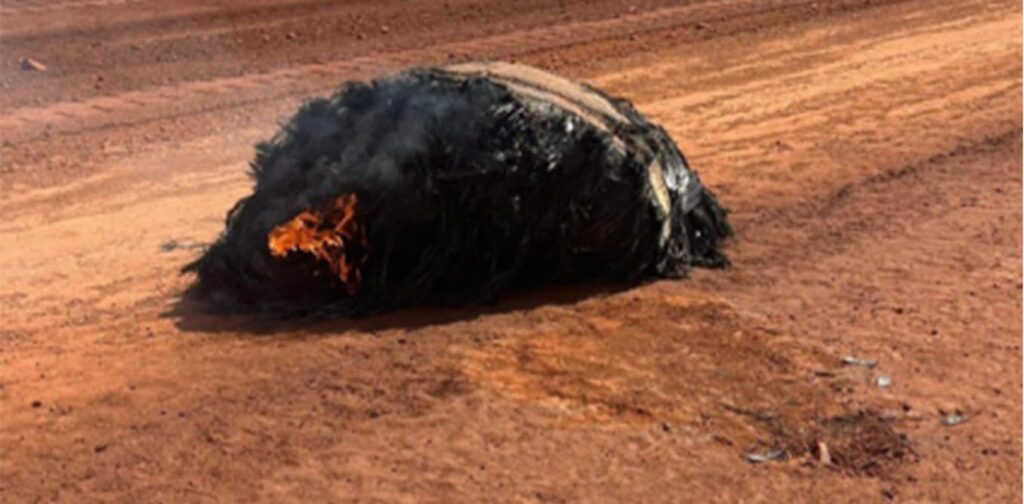
A piece of space debris ignited and fell to Earth on October 18, landing in the remote Pilbara region of Western Australia. Mine workers discovered the flaming object lying on a dirt road, prompting immediate investigations by local authorities. The Western Australia police reported that initial assessments indicated the object was made of carbon fibre and appeared to be consistent with previously identified space debris.
Experts have linked the debris to a Chinese Jielong-3 rocket, which was launched in September 2023 to deploy twelve satellites into low Earth orbit. The orbital path of the rocket’s fourth stage coincided with the discovery of the debris, further supporting this theory. The Australian Space Agency has stated that the debris is “likely a propellant tank or pressure vessel from a space launch vehicle” and is planning further technical analysis to confirm its origin.
The incident highlights the escalating issue of space junk, which has become a point of concern for space agencies and environmentalists alike. The area surrounding Earth is increasingly crowded, with over 10,000 active satellites and an estimated 40,000 pieces of space debris larger than ten centimeters. Projections suggest that by the end of the decade, the number of satellites in low Earth orbit could reach as high as 70,000.
The term “space junk” refers to any human-made material in orbit that no longer serves a purpose. This includes defunct satellites and discarded rocket stages. Most of this debris is expected to re-enter the Earth’s atmosphere, where it burns up due to friction and heat. However, spent rocket stages pose the greatest risk, as they often survive re-entry and can reach the ground intact.
Recent research presented at the International Astronautical Congress in Sydney identified the fifty most concerning pieces of space junk in low Earth orbit, with 88% of these classified as rocket bodies. Alarmingly, the rate of new debris creation is outpacing the rate at which existing debris re-enters the atmosphere. This not only poses risks of collision in space but also generates harmful particulates that can impact the ozone layer.
The atmospheric re-entry of space debris is typically uncontrolled. Once a spacecraft depletes its fuel or battery power, its orbit begins to drift unpredictably. While many re-entries occur over oceans or uninhabited areas, there have been instances where debris has fallen near populated regions, such as the crash of parts of a Chinese rocket in April 2022, which startled residents in the Indian village of Ladori.
One approach to managing space debris is called passivation, which involves depleting all fuel and batteries in a spacecraft to prevent explosions. Conversely, controlled re-entries aim to guide spacecraft to designated areas with minimal risk, such as the “space cemetery” in the Pacific Ocean, where approximately 300 spacecraft currently lie on the ocean floor.
Determining the ownership of the debris found in Australia will be the first step in addressing the incident. According to the 1967 Outer Space Treaty, the state that authorized the launch of a rocket or satellite is liable for any damage it causes on Earth. If the debris is confirmed to be from a Chinese rocket, Australia will likely engage with Chinese authorities regarding its return or appropriate disposal.
Fortunately, the rocket body did not cause any harm, and the negotiations are not expected to involve liability claims. The debris landed in an area already significantly affected by mining activities, reducing the likelihood of environmental damage claims.
As space activities increase, better end-of-life planning for satellites and other space vehicles is essential. Previously, the standard was that no spacecraft should remain in orbit after 25 years post-mission. Now, the expected standard is a mere five years for low Earth orbit. Innovative technologies are being developed to service and refuel satellites to extend their operational life.
The European Space Agency is championing the Zero Debris Charter, which encourages participants to commit to becoming debris-neutral by 2030. While the amount of debris re-entering the atmosphere is expected to increase in the short term, there is optimism that international collaboration and technological advancements will promote sustainable practices in space, ensuring future generations can access it safely.
Alice Gorman, a Fellow of the Outer Space Institute, underscores the importance of addressing these challenges as humanity continues to venture further into space.







